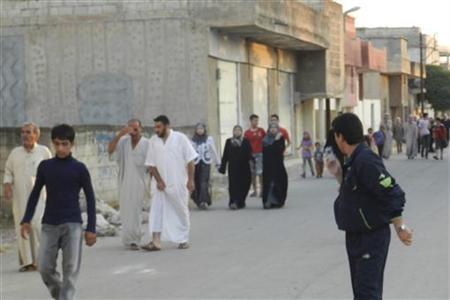(This story is based on the observations of a visitor to Syria, known to Reuters. His identity has been withheld for safety reasons)

(Reuters) – The view from the rooftops makes the balance of power clear. In some neighborhoods, cars and people scurry about. In others, only the scarred shells of empty homes remain.
After months of fierce military assaults and rebel ambushes in Homs, the centre of Syria’s 15-month-old revolt against President Bashar al-Assad has effectively become two cities.
Along the scorched and crumbling skyline is a well-preserved archipelago of districts, home to Syria’s minority Alawite sect, the offshoot of Shi’ite Islam to which Assad belongs.
Alawites have mostly sided with Assad and have barricaded themselves in Homs – protected by the Syrian army that has now made their neighborhoods a second home.
“We’re always nervous, but we will stay and survive,” says Abu Ali, a 60-year old sitting in his mini market in the Alawite neighborhood of Zahra.
“It is the Sunni areas that are empty – at least the ones that asked for ‘freedom’,” he said, referring to districts that backed the mainly Sunni Muslim uprising against Assad.
The rebellious districts that once belonged to Sunni Muslims are ghost towns. Only about three of the 16 Sunni districts have not been pummeled by military assaults.
Many Alawites say they feel they have no choice but to back Assad, fearing retaliatory slaughter for religious affiliation with the president as the revolt becomes increasingly sectarian.
“The Sunnis have been oppressed,” said one Alawite man. “But Alawites will be the victims.”
Abu Ali settles in his chair as cans and jars lined up in his store rattle from the daily bursts of gunfire and rockets. Behind him, an Assad portrait adorns the back wall.
“Those other people are the terrorists,” he says, pointing to several cases of Alawites being kidnapped or killed by rebels. ” I can tell you what is happening: War.”
SLEEPING IN BUTCHER SHOPS
More people are starting to agree. The United Nations’ peacekeeping chief recently said Syria’s conflict looked like a civil war.
While many areas have still escaped sectarian brutality, the heart of Syria’s conflict is a chilling glimpse of what the worst case scenario may be: a bloody struggle that tears the country into a jigsaw of warring statelets.
The Syrian government describes rebels fighting Assad as foreign-backed terrorists and accuses international media of misrepresenting the situation as a popular uprising against the president. But it allows little access to the country for foreign correspondents.
The city of Homs was once the country’s industrial centre, sitting on Syria’s main north-south highway, 30 km (20 miles) east of the border with Lebanon.
It became the stronghold of the armed insurgency that began several months ago and overtook the peaceful protests against 42 years of Assad family rule.
With Sunni areas pounded into a shambles, refugees too poor to leave Homs have few options.
Most end up in the Waar district, a jungle of concrete apartment blocks that housed the Sunni elite. Waar’s affluent residents fled the city’s chaos. Soon refugees broke in and took over their abandoned apartments.
All down the streets, shops have been seized by refugees. At a butcher shop, a family has hung blankets across the meat hooks outside to cover the glass storefront.
Refugees have even moved into shopping malls, and the former stores are now crammed with blankets and stoves
Outside, Abu Omar looks for handouts for his six children, who have been given shelter in a local mosque.
“We’re living off the charity of others. And we are lucky, some people are on the streets,” he says.
Homs used to be home to around 1 million people. Now, residents casually estimate that at least half have fled.
MILITARISED ALAWITES
Meanwhile, Alawite areas like Farzat’s Zahra district look more like army bases than residential neighborhoods.
Artillery is no longer stored in army barracks on Homs’s outskirts but in the middle of Alawite districts, and troops are at the ready to roll them out and fire at nearby rebel areas.
The army has secured the streets connecting Alawite neighborhoods. But its control of Homs is tentuous.
Soldiers dare not go into most Sunni areas, where somewhere unseen in rocket- and bullet-riddled buildings, hundreds of rebels hide, sporadically firing rocket propelled grenades.
“If we wanted to end the Homs problem, we’d have to grind the whole place to the ground. Hundreds of soldiers would die,” said an army officer.
He said he was part of the siege of Homs’s Baba Amr neighborhood, when an onslaught by tanks and troops drove rebels out of their main stronghold.
“We’re worried houses will be mined, like they were in Baba Amr. That struggle cost us many more men than was reported. So now instead, we just shell the rebel areas from here.”
In addition to troops, hundreds of pro-Assad militia men have been cultivated in Alawite areas, proudly accepting the tag “shabbiha”, from the Arabic word “ghost.” They strut down the streets in army camouflage. They speak disdainfully of soldiers they view as treading too cautiously in confronting the enemy.
One shabbiha youth points to the tower overlooking an opposition area, where soldiers used to snipe at rebels.
“Now the shabbiha use it. You can’t see people over there, there’s no point sniping. We just take a machine gun and spray.”
BACK TO SCHOOL
Despite the overt militarization, Alawite residents try to maintain a normal way of life. Most schools are open. Vendors hawk fruit and vegetables on street corners.
Nearby, women browse shops that have become a “Sunni market”, where shabbiha bring in stolen furniture and clothes from Sunni areas after the army has raided them.
“These are the spoils of war,” one woman shrugs. “It’s our right to take them.”
But the mood is always tense, and like many other days, the calm shatters along with the glass of a shopfront as an RPG launched by rebels smashes into the street. A bloodied passerby is quickly given first aid and whisked away by ambulance.
The government has pushed for the appearance of normality in the midst of chaos. Homs’ Baath University reopened last week after a long closure. For the first time in months, Sunni and Alawite classmates were placed under the same roof.
But the division is as palpable here as in their fractured city. Sunni and Alawite students stick to their own sides, sitting on opposite ends of cafeterias and a campus yard overshadowed by a massive stone statue of former president Hafez al-Assad, Bashar’s father who ruled for nearly 30 years.
“I used to have a lot of Alawite friends, but now we don’t greet each other. There is nothing more to say,” says Ahmad, a 22-year old Sunni engineering student. “But I’m not afraid, it can’t get any uglier than this.”
Across the yard, fellow engineering student Hassan, an Alawite, fears the worst is yet to come.
“Even my cousins are shabbiha now. I hate that. Neither side deserves power here,” he sighs.
Hassan never says he thinks Assad may be toppled, but he believes the future will not be kind to Alawites.
“The slaughter is coming to us.”
(Writing by Erika Solomon; editing by Ralph Boulton)





